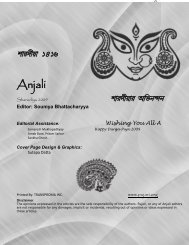Sharodiya Anjali 2005 - Pujari
Sharodiya Anjali 2005 - Pujari
Sharodiya Anjali 2005 - Pujari
You also want an ePaper? Increase the reach of your titles
YUMPU automatically turns print PDFs into web optimized ePapers that Google loves.
__________________________________________________________________Durga Puja <strong>2005</strong><br />
Dr. Sarita Kansal<br />
M.D., MPH<br />
Coronary Artery Disease<br />
(CAD) should now be considered<br />
an important public health problem<br />
in immigrant Indians. It is a part of<br />
the epidemiological transition<br />
characterized by changing<br />
lifestyles and a probable genetic<br />
predisposition The high rates of<br />
CAD in Asian Indians appears to<br />
be a global phenomenon, shared by<br />
the inhabitants of the four<br />
countries of the Indian<br />
subcontinent (India, Pakistan,<br />
Bangladesh and Sri Lanka) as well<br />
as immigrants from these countries<br />
to various regions of the world.<br />
The CAD rates among overseas<br />
Asian Indians worldwide are 50%<br />
to 400% higher than people of<br />
other ethnic origin irrespective of<br />
gender, religion, or social class.<br />
Whereas the CAD rates halved in<br />
the West in the past 30 years, the<br />
rates doubled in India with no<br />
signs of a downturn yet. Among<br />
Asian Indian men, about half of all<br />
MI occur under the age of 50 and<br />
25% under the age of 40.<br />
The high rates of CAD in Asian<br />
Indians are due to a combination of<br />
nature (genetic predisposition) and<br />
nurture (lifestyle factors). The<br />
lifestyle factors include those<br />
associated with affluence and<br />
urbanization as well as<br />
immigration and acculturation.<br />
Urbanization is accompanied by<br />
decreased physical activity and<br />
increased consumption of fat<br />
Dr. Kansal is a board certified cardiologist with advanced level III training in echocardiography and<br />
board certified in Nuclear Cardiology. Born in India, she received her medical degree from Maulana<br />
Azad Medical College, New Delhi. Dr. Kansal completed her internship and residency at Southern<br />
Illinois University in 1997 and was on faculty as assistant professor until 2000. She subsequently did<br />
her cardiology fellowship at Vanderbilt University and a fellowship in echocardiography at Emory<br />
University. Dr. Kansal joined Cardiovascular Medicine, P.C. in September 2004. She is also Clinical<br />
Assistant Professor of Medicine at Emory University. Dr. Kansal is a Cardiologist at Cardiovascular<br />
Medicine, P.C. in Marietta. She sees patients by appointment. Phone 770-424-6893.<br />
Double Jeopardy from Nature & Nurture<br />
resulting in “metabolic syndrome”.<br />
This syndrome consists of<br />
dyslipidemia, glucose intolerance,<br />
central obesity, and hypertension.<br />
However, apart from metabolic<br />
syndrome, they have no excess of<br />
conventional risk factors such as<br />
cigarette smoking, hypertension,<br />
and high cholesterol levels. Nearly<br />
half of them are life-long<br />
vegetarians. This excess burden of<br />
premature CAD in Asian Indians is<br />
due to a genetic susceptibility,<br />
mediated through elevated levels of<br />
lipoprotein (a). Lp(a) magnifies the<br />
adverse effects of lifestyle factors<br />
Asian Indians appears to have a<br />
unique pattern of dyslipidemia, a<br />
'deadly lipid tetrad’. This lipid<br />
tetrad consists of elevated Lp(a) in<br />
combination with high LDL, high<br />
triglycerides and low HDL. Lp(a)<br />
levels >40 mg/dL (versus




